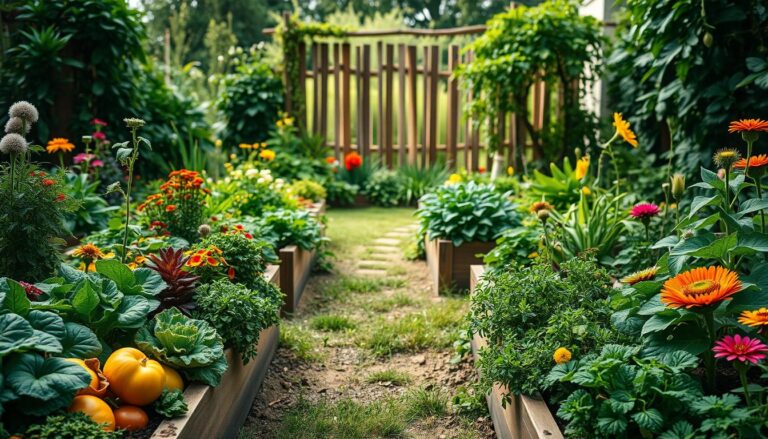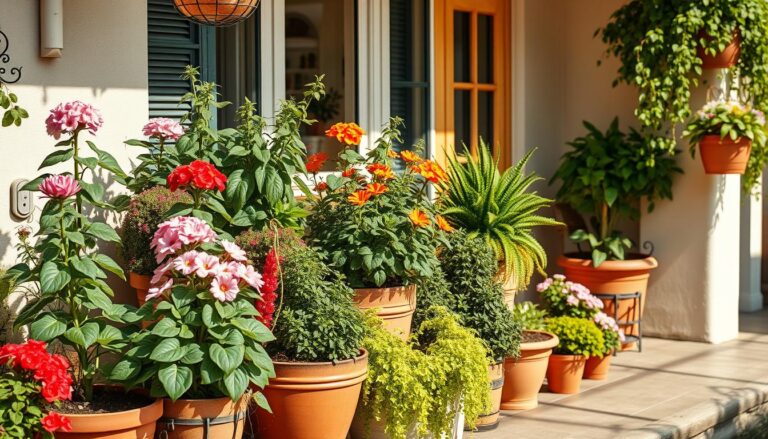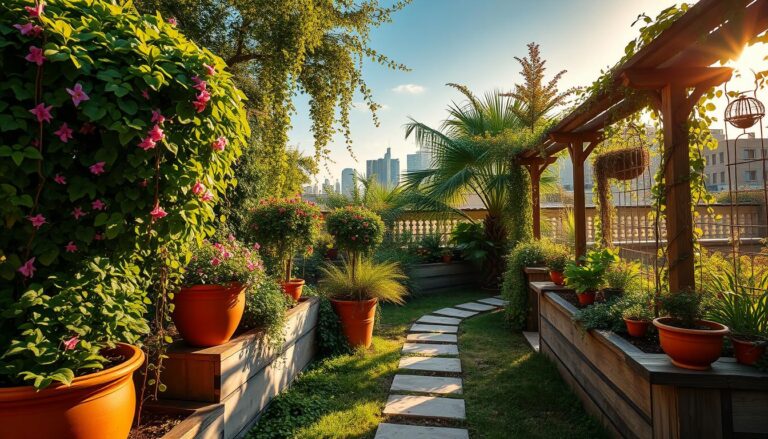Top 10 Wild Flower Garden Ideas for Landscaping
This post contains affiliate links, meaning I may receive a small commission if you make a purchase through my links, at no extra cost to you.
Imagine stepping into your own serene oasis, surrounded by vibrant colors. The gentle rustle of wild flowers in the breeze is soothing. Creating a wild flower garden is more than just making your outdoor space look good. It’s about making a haven that attracts pollinators and connects you with nature.
With the right garden design, you can turn your yard into a stunning display of natural beauty. Adding wild flower garden ideas to your landscaping boosts biodiversity and cuts down on maintenance. It also gives your garden a unique look that makes it stand out.
Key Takeaways
- Enhance your garden’s biodiversity with wild flowers.
- Reduce garden maintenance with the right design.
- Create a unique visual appeal with natural beauty.
- Attract pollinators and support the local ecosystem.
- Transform your yard into a serene oasis.
The Magic of Wild Flowers in Your Landscape
Wild flowers add magic to your garden, making it more beautiful and good for the environment. They help create a lively space that draws in pollinators and boosts biodiversity.
Ecological Benefits of Growing Wild Flowers
Wild flowers in your garden offer many ecological perks. They draw in bees and butterflies, which are key for many plants to reproduce. They also improve soil health and help local wildlife.
- Attract pollinators and support biodiversity
- Enhance soil health through deep root systems
- Provide habitat for local wildlife
Planning Your Wild Flower Project
To make wild flowers work in your garden, you need a good plan. First, pick the right types for your area’s climate and soil. Think about sunlight, soil moisture, and how much upkeep you can handle.
Key considerations:
- Choose wild flowers suitable for your region
- Assess your garden’s conditions (sunlight, soil, etc.)
- Plan for ongoing maintenance
1. Create a Meadow-Style Wild Flower Garden
Turning your outdoor area into a meadow-style wild flower garden can make it more beautiful. This type of garden has many wild flowers, grasses, and plants that need little care. Renowned landscape designer, Piet Oudolf, once said, “The meadow garden is a celebration of nature’s beauty, where plants grow and bloom freely.”
“The meadow garden is a celebration of the beauty of nature, where plants are allowed to grow and bloom in their natural habitat.” – Piet Oudolf
Best Flowers for American Meadow Gardens
Choose native American wild flowers for your garden. They fit well with your local climate and soil. Some great picks are:
- Black-Eyed Susans
- Coneflowers
- Butterfly Weed
Black-Eyed Susans: Planting and Care
Black-Eyed Susans are loved for their bright yellow and dark centers. Plant them in full sun and well-drained soil. Water them often in the first year.
Coneflowers: Cultivation Tips
Coneflowers are great for attracting pollinators and adding height. Plant them in well-drained soil and full sun. Water them regularly in the first year.
Meadow Garden Establishment Techniques
To start a meadow garden, prepare your soil by tilling or scarifying. Then, plant your wild flower seeds in the fall or early spring. Keep the garden by mowing it every year and controlling weeds.
2. Design a Butterfly and Bee Haven
Creating a garden for butterflies and bees is simple. Just add pollinator-friendly wild flowers. This makes your garden beautiful and helps the local ecosystem.

Top Pollinator-Attracting Wild Flowers
Some wild flowers attract butterflies and bees better than others. Here are a few top picks:
- Milkweed, a vital plant for Monarch butterflies
- Bee Balm, a favorite of hummingbirds and pollinators
- Butterfly Weed, a brightly colored flower that attracts a variety of butterflies
Milkweed: Growing for Monarchs
Milkweed is key for Monarch butterflies. It’s the only food for their caterpillars. Plant it in full sun and well-drained soil. Asclepias species are native to many parts of North America, making them a great choice for a pollinator-friendly garden.
Bee Balm: Cultivation and Benefits
Bee Balm is a fragrant herb that attracts many pollinators. It loves moist soil and partial shade. This perennial flower is not only beautiful but also attracts hummingbirds, adding to your garden’s biodiversity.
Creating Pollinator-Friendly Habitats
To make a pollinator-friendly habitat, follow these tips:
- Plant a variety of flowers that bloom at different times to provide a constant nectar source.
- Avoid using pesticides, which can harm or kill pollinators.
- Provide shelter and nesting sites for bees and butterflies.
By following these guidelines, you can create a thriving haven for butterflies and bees. This supports the local ecosystem and brings beauty to your garden.
3. Establish a Prairie-Inspired Wild Flower Garden
You can create a beautiful prairie-inspired wild flower garden by picking the right native flowers. Prairie gardens are stunning and need less care than regular gardens. They’re great for those who want a diverse landscape that helps local wildlife.

Native Prairie Flowers for Your Region
Choosing native prairie flowers is key for a healthy prairie garden. Some top picks include:
- Blazing Star, known for its vibrant purple spikes
- Prairie Clover, which attracts pollinators and adds color
- Black-eyed Susan, a daisy-like flower that is easy to grow
Blazing Star: Planting and Maintenance
Liatris species, also known as Blazing Star, love full sun and well-drained soil. They need little care and add a bold splash of color.
Prairie Clover: Growth Requirements
Prairie Clover does best in well-drained soil and full sun. It’s a legume that fixes nitrogen, helping your garden grow strong.
Prairie Garden Establishment and Care
To start a prairie garden, mix native grasses and flowers into the soil. Keep it up with regular mowing and controlled burns to mimic nature. With the right care, your prairie garden will bloom, offering a stunning and eco-friendly space.
4. Develop a Woodland Edge Wild Flower Display
Want to bring the forest’s calm to your yard? Try a woodland edge wild flower display. It’s a special garden that looks like a forest edge, blending beautifully with its surroundings.

This garden uses flowers that do well in shade. It’s designed to look natural and easy to care for. You’ll get a stunning outdoor area without much work.
Shade-Tolerant Wild Flowers to Consider
For your woodland edge garden, pick flowers that love shade. Here are some great ones:
- Virginia Bluebells: These blue flowers are a favorite for woodland gardens.
- Woodland Phlox: It’s fragrant, comes in many colors, and loves shade.
Virginia Bluebells: Cultivation Tips
Plant Virginia Bluebells in moist, well-drained soil and partial shade. They spread over time, making a stunning blue carpet in spring.
Woodland Phlox: Growing Guide
Woodland Phlox likes rich, moist soil and some shade. It’s easy to care for and attracts butterflies and hummingbirds, boosting your garden’s life.
Creating and Maintaining Woodland Edges
To make a great woodland edge, first check your garden’s light and soil. Pick plants that fit your area’s climate and soil. Regular care, like mulching and weeding, keeps your garden looking great.
With these tips and the right plants, you’ll have a peaceful woodland edge wild flower display. It will make your outdoor space even more beautiful.
5. Install a Rain Garden with Wild Flowers
A rain garden with wild flowers can make your yard look amazing. It also helps the environment. Rain gardens catch and filter rainwater, reducing runoff and supporting wildlife.

Choosing the right wild flowers is key when setting up a rain garden. You need plants that love moist soil. Rain gardens are made to hold water temporarily.
Moisture-Loving Wild Flower Species
Some wild flowers are perfect for rain gardens because they love wet soil. Here are a few:
Cardinal Flower: Wet Soil Specialist
The Cardinal Flower (Lobelia cardinalis) is a great pick. It has bright red flowers that attract hummingbirds and other pollinators. It grows well in wet soils and partial shade.
Swamp Milkweed: Planting Guide
Swamp Milkweed (Asclepias incarnata) is also a top choice. It has clusters of fragrant, pink or purple flowers. It likes moist to wet soils and full sun to partial shade.
Rain Garden Construction and Maintenance
To build a rain garden, pick a spot that collects rainwater. Dig a shallow hole, adjust the soil if needed, and plant your wild flowers. Keep the garden draining well and fight weeds to maintain it.
6. Design a Rock Garden with Drought-Resistant Wild Flowers
Creating a rock garden with drought-tolerant wild flowers is a great idea. These gardens are beautiful and easy to care for. They’re perfect for spots with bad soil or little water.

When picking wild flowers for your rock garden, choose ones that love dry conditions. Blanket Flower and Yarrow are great choices. They’re tough and have beautiful flowers.
Drought-Tolerant Wild Flower Selection
For a rock garden to thrive, pick wild flowers that need little water. Two top picks are:
Blanket Flower: Growing in Poor Soil
Gaillardia is a strong perennial that does well in bad soil and lots of sun. It blooms with bright, daisy-like flowers all summer.
Yarrow: Drought-Resistant Beauty
Achillea millefolium is a wild flower that’s both versatile and drought-tolerant. It has fern-like leaves and clusters of small, fragrant flowers.
Rock Garden Installation and Minimal Care
To start a rock garden, pick a spot with good drainage and lots of sun or partial shade. Clean the soil by removing weeds and adding organic matter. Plant your chosen wild flowers and mulch around them to keep moisture in and weeds out. Caring for it is easy, with just occasional weeding and watering when it’s very dry.
7. Create a Wild Flower Garden Border for Stunning Edges
Wild flower garden borders mix natural beauty with structured landscaping. By picking and arranging wild flowers, you can make a stunning edge. This not only boosts your garden’s look but also helps local wildlife.
Border-Perfect Wild Flowers
When picking wild flowers for your border, choose ones that are beautiful and fit the edge environment. Purple Coneflower and Wild Columbine are great picks.
Purple Coneflower: Border Standout
Purple Coneflower (Echinacea purpurea) is a hardy perennial that makes any border stand out. Its big, eye-catching flowers draw in pollinators and add a bold splash of color.
Wild Columbine: Edge Planting Tips
Wild Columbine (Aquilegia canadensis) is perfect for garden borders. It loves well-drained soil and partial shade. Plant them 12-18 inches apart to let them grow well.

Seasonal Border Maintenance
Keeping your wild flower garden border in good shape is key. Tasks include removing dead plants in early spring, watering when it’s dry, and using mulch to keep moisture in.
In the fall, cut back perennials to 3-4 inches from the ground. This protects the roots and helps them grow strong in the spring.
8. Establish a Wild Flower Cottage Garden
Creating a wild flower cottage garden can make your outdoor space more beautiful. Cottage gardens are known for their cozy, informal look. They mix flowers, herbs, and shrubs together. Start by picking flowers that grow well in your area.

Traditional Cottage Garden Wild Flowers
Some top picks for cottage gardens are Evening Primrose and Wild Foxglove. These flowers bring color and texture. They also draw in pollinators.
Evening Primrose: Cottage Garden Star
Evening Primrose blooms in the evening, attracting moths and other pollinators. It’s easy to care for and grows well in poor soil.
Wild Foxglove: Growing Guidelines
Wild Foxglove adds tall spikes of flowers to your garden. It attracts bees and other pollinators. It likes well-drained soil and partial shade, perfect for woodland edges.
Cottage Garden Layout and Upkeep
Plan your garden with different heights, textures, and bloom times for interest. Keep it up by watering, weeding, and pruning. Follow these steps to make a stunning wild flower cottage garden in your backyard.
9. Transform Your Front Yard with Wild Flowers
You can make your home’s exterior look amazing with a wild flower front yard garden. Wild flowers add natural beauty and boost your curb appeal. By picking the right flowers and taking care of them, you can create a beautiful welcome for everyone.

Curb Appeal Wild Flower Selections
Picking the right wild flowers is key for great curb appeal. Here are some top picks:
Wild Bergamot: Front Yard Focal Point
Monarda fistulosa, or Wild Bergamot, is a fragrant flower that’s pink to lavender. It attracts pollinators and adds texture to your garden.
Black-Eyed Susan: Neighborhood Pleaser
Black-Eyed Susans (Rudbeckia hirta) are bright, daisy-like flowers. They’re easy to care for and brighten up your yard all summer.
Front Yard Wild Flower Maintenance
To keep your wild flower garden looking great, regular care is needed. This includes watering when it’s dry, pulling weeds, and reseeding where flowers fade. With these simple steps, your wild flower garden will thrive for years.
10. Create a Wild Flower Container Garden
You can make a beautiful wild flower garden in containers, great for small spaces. Container gardening with wild flowers brings beauty to your outdoor area. “Container gardens can be just as vibrant and diverse as in-ground gardens,” says gardening expert, Claudia West. Wild flowers in containers need the right care and choice to thrive. This way, you can control the soil and drainage, key for your wild flowers’ health.

Container-Suitable Wild Flowers
When picking wild flowers for containers, choose compact or trailing types. Wild Petunias and Prairie Zinnia are great. They have bright colors and do well in containers.
Wild Petunias: Container Care
Wild Petunias are drought-tolerant and bloom a lot. To care for them, make sure the soil drains well and they get full sun to partial shade.
Prairie Zinnia: Pot Cultivation
Prairie Zinnia is also a good pick, drawing pollinators and adding color. For growing in pots, use a mix that drains well and make sure they get enough sunlight.
Container Selection and Seasonal Care
The right container is crucial for your wild flower garden’s health and look. Pick containers with holes for drainage to avoid soggy soil. Seasonally, refresh the potting mix and trim plants to keep them strong.
Conclusion: Bringing Wild Beauty to Your Landscape
Adding wild flowers to your garden can make it lively and full of life. This article shared 10 great ideas for wild flower gardens. These ideas can make your outdoor space more vibrant and eco-friendly.
These ideas range from meadow gardens to container gardens. Each one highlights the beauty and benefits of wild flowers. By picking the right flowers for your area, you can have a beautiful garden that’s easy to care for.
Looking to attract bees, improve your home’s look, or just enjoy nature? These garden ideas can help. So, start today and add some wild beauty to your garden.
FAQ
What are the benefits of having a wild flower garden?
A wild flower garden attracts pollinators and boosts biodiversity. It also adds beauty to your landscape. Plus, these gardens need less care since they match your local climate and soil.
How do I choose the right wild flowers for my garden?
When picking wild flowers, think about your climate, soil, and sunlight. Also, decide on the garden style you prefer, like a meadow or cottage garden.
What are some low-maintenance wild flower options?
For easy care, try Black-Eyed Susans, Coneflowers, and Yarrow. They’re good for busy gardeners because they’re drought-tolerant and need little care.
How do I maintain a wild flower garden?
To keep a wild flower garden, water, mow, and fertilize as needed. You might also need to fight weeds and pests. The care depends on your plants and local weather.
Can I grow wild flowers in containers?
Yes, you can grow wild flowers in containers. Use deep containers for the plants’ roots. Choose a mix that drains well and follow the growing instructions for your plants.
How do I create a pollinator-friendly wild flower garden?
For a garden that helps pollinators, pick flowers with lots of nectar and pollen. Choose Milkweed, Bee Balm, and Purple Coneflower. Plant a variety that blooms at different times for constant food for pollinators.
What are some tips for designing a beautiful wild flower garden?
To design a stunning wild flower garden, think about color, texture, and height. Mix annuals and perennials for blooms all season. Add rocks, logs, or paths for interest.
Can I use wild flowers in a rock garden or lawn and garden design?
Yes, wild flowers work well in rock gardens or lawn designs. Use drought-tolerant flowers like Blanket Flower and Yarrow in rock gardens. Add wild flowers to lawns for color and texture.
How do I care for bushes in front of my house with a wild flower garden?
To care for bushes with a wild flower garden, water and fertilize them as needed. Prune regularly to keep their shape. Plant wild flowers around the bushes for a cohesive look.







